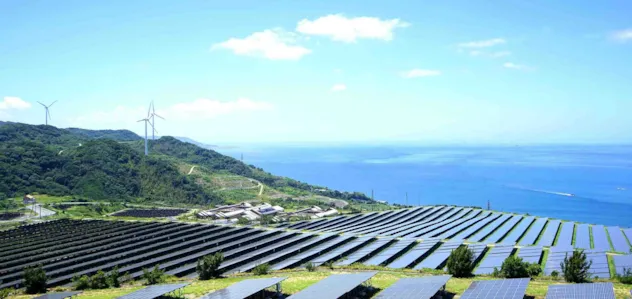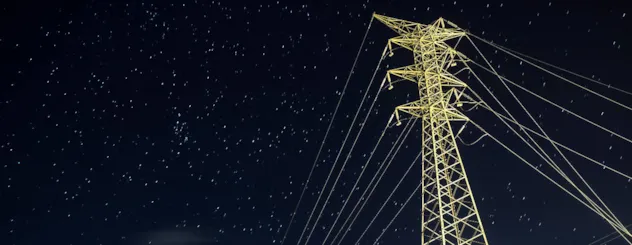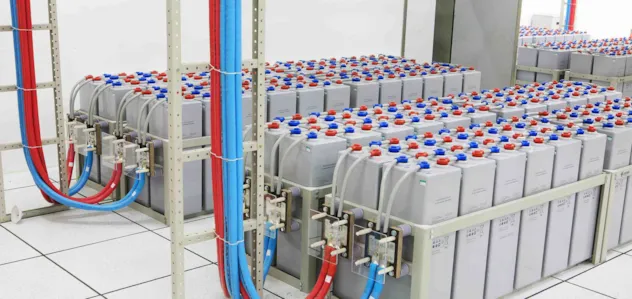December 06, 2017 | Podcast
Renewables integration: the importance of storage
| Transcript: |
|---|
Transcript:NARRATOR Welcome to the DNV Talks Energy podcast series. Electrification, rise of renewables and new technologies supported by more data and IT systems are transforming the power system. Join us each week as we discuss these changes with guests from around the industry.
|
Transcript:MATHIAS STECK Welcome to a new episode of DNV Talks Energy. Our guest today is Paul Gardner, Segment Director Storage of DNV. Welcome Paul.
|
Transcript:PAUL GARDNER Thank you for having me.
|
Transcript:MATHIAS STECK Paul, DNV here at the Singapore International Energy week has launched, at least for Singapore, its Energy Transition Outlook and there is a lot about the importance of renewables, in the future, going forward and, with that, we come into a future where grids will have to deal with the variability and intermittency of renewables generation. You, as a leader in storage in DNV, can maybe, briefly before we jump into that topic, explain a bit what you are doing in DNV and then we talk how storage and maybe other technologies can help us handle this scenario.
|
Transcript:00:00:53
|
Transcript:PAUL GARDNER Yes, so, in DNV, storage is seen as an area of rapid growth in the world and of great interest for us. We have, currently, several established teams who have extensive experience, particularly in testing of storage devices, particularly batteries. We also, in our maritime business area, have substantial experience with dealing with the safety issues of large batteries in enclosed spaces in vessels. So, my job is to coordinate our activities in storage around the company, around the globe, to make sure that we are sharing experience wherever we can and that we are achieving common standards in our delivery of services to customers.
|
Transcript:MATHIAS STECK Right, thank you. So, again, maybe setting the scene of it, in our report we are saying that from today to 2050 the electricity demand will grow by about 140%, and we’re also are saying that 72% of the electricity will be generated by renewables, 36% solar, 24% onshore wind, 12% offshore wind; and that brings us to what I mentioned at the beginning – this high variability or intermittency – depending on which technology you are talking about – of the generation connected to the grid.
So, what would we say, how can we handle such a scenario? |
Transcript:00:02:22
|
Transcript:PAUL GARDNER So, the first thing to say is that storage is useful for that but it is not essential. And on its own it is probably not sufficient to deal with the issues of high variability of, particularly wind and PV. There are other solutions and those solutions, typically, are greater electrical interconnection across countries and between countries, and even between continents eventually; flexible generation particularly gas turbines where we are seeing great developments by the gas turbine manufacturers in making their products more flexible, and demand site management / demand site response which also provides a great deal of flexibility and, to some extent, all these options are competing with storage for providing the necessary services to run grids with high penetration available in renewables.
|
Transcript:MATHIAS STECK Right. So, since we have you here as Segment Director Storage, I’d like to focus a little bit on storage and I am happy to come to other technologies maybe a little bit later. But what I always found interesting discussing with you when we were talking about business cases for storage, because I understood only storing energy or electricity for some time and then releasing it then is, very often, not enough of a business case for storage. So, maybe you could explain a little bit what that means to make storage useful?
|
Transcript:00:03:51
|
Transcript:PAUL GARDNER Yes, so, it is quite interesting to look at what storage already exists on electricity systems and most of it, in fact the vast majority – over 95% of it – is pumped hydro. And it is interesting to consider why that is there and the justification for building on that pumped hydro capacity, most of that justification has been exactly this: Energy arbitrage – being able to sell the energy at high price periods or high value periods. However we see, currently, that that is not sufficient. And even in the case of the UK, the pumped hydro capacity in the UK just now, most of its income is not coming from that energy arbitrage, it is coming from providing ancillary services capacity and frequency response. So, the lesson for pumped hydro applies equally, particularly in batteries, that the energy transfer, the time delay of energy is not sufficient to economically justify the costs of building the storage. Most of the value we see comes from providing ancillary services, particularly frequency response.
|
Transcript:MATHIAS STECK Right. When we talk about renewables and the requirements to make them really grow as fast as we need them to grow, we are also talking about regulatory issues. And I would believe the same applies for technologies like storage, so, what about regulatory requirements for storage?
|
Transcript:PAUL GARDNER There are some regulatory barriers. We have found previously in the growth of renewables, that actually regulatory issues can be serious impediments because of the structural delays that are inherent in regulation. Regulation is very close to legislation and it needs, for very good reasons, it needs time to get consensus and for everyone to understand what’s happening and what is being proposed.
|
Transcript:00:05:53
|
Transcript:And those regulatory delays, themselves, are barriers even if everyone agrees what has to happen, just the time taken to implement it can cause significant delays. So, for example, in some countries there have been significant delays in the ability to implement storage because there has not been a common definition of what storage actually is, in terms of the electrical system. And that sounds silly but, actually, it’s important because, in some countries, they operate through systems of licensees, so there are generator licensees, and network operator licensees, and there are energy supply licensees. And it is not clear, in those lisenced environments, it is not clear exactly where storage fits. If it can be considered as a generator, then that has different implications than if it is considered as something that a network operator can do. And that is important for storage because storage, actually, the inherent technology provides benefits both to generators and to network operators.
|
Transcript:00:07:01
|
Transcript:So, it is important who actually gets those benefits; who is allowed to gain those benefits. And so, that is one of the regulatory barriers that comes in the way of storage; that is probably the dominant one, just the pace of regulatory change.
|
Transcript:MATHIAS STECK Right. Although we see storage, in relatively large scale, being built in some countries, so, I most recently remember news from Australia where, I think, AGL is doing a 250 megawatt storage facility and Tesla is doing 100 megawatt project. Costs seem to be perceived still relatively high for storage and I think we have earlier agreed that there is a lot of potential still for technology advancements also in storage. So, what is your view on the cost development in future and where that technology will go?
|
Transcript:PAUL GARDNER Well, just last week I was in a battery manufacturing plant and it’s really very impressive how automated the manufacturing is. And my view is that we will see a substantial cost reduction to come just from manufacturing improvements and increases in volume. And it is worth noting that, particularly for batteries, that around about 90% of the batteries that are being manufactured now, for long term energy storage, rechargeable batteries, are being manufactured for electric vehicles. Not for stationary storage, for grid connected storage of the kind we are talking about today. So, it is actually the electric vehicle market that is driving these manufacturing improvements, and those will drive the cost reductions.
Now, with a big enough market, and enough time, we will definitely see significant technical improvements. New technologies will emerge but currently we don’t see any game changers on the horizon, or possibly there are some, but nothing that we can see has a very good chance of making a very big difference in the next few years. |
Transcript:00:09:06
|
Transcript:The difference in the next few years is going to be achieved by volume manufacturing and small-scale improvements to the existing technologies.
|
Transcript:MATHIAS STECK What would be great, Paul, if you could maybe talk a little bit about the different types of storage technologies for different purposes. I think one thing I am observing, if we go for the maybe leading electric vehicle / battery manufacturers these days, the big battery is basically just a stack of a lot of small batteries and they just make bigger and bigger bundles. But I am not entirely sure if this is necessarily the best answer to what we actually need on the grid. Obviously it has an advantage that you have more leverage on cost because you can, kind of, replicate the same thing a lot of times, but there must be different types of storage with different applications on the grid. I think in the beginning a little bit you elaborated on this already, but if could give us a bit more of an overview there, what technologies are out there.
|
Transcript:PAUL GARDNER Yes, so, the battery technologies are very much, as you have said, they are small units produced in very large quantities and combined in some modules or packs or bundles. We should not forget that there is also the flow battery technologies, which are an entirely different technology and rely upon effective storage of chemicals in large tanks. So, that has different economic drivers and we can expect, therefore, that we could fill a different economic niche.
|
Transcript:00:10:48
|
Transcript:So, those are the battery type technologies for storage. There’s also many other forms – flywheels, for example, which are very good at storing power for being able to deliver a large amount of power in a very short time. So, for some applications, fly wheels will be attractive. And we also see capacitors, super capacitors which, again, are able to deliver very large amounts of power in very short time scales. The time scale issue is a very good way of looking at storage technologies. So, we have just talking about the ones that can delivery large amounts for very short durations, there are other applications that require power over longer periods.
Now some battery technologies are suitable for that, the flow batteries particularly are, but then we go into even longer time scales, and then we are looking at the existing technology like pumped hydro, like we mentioned before, or even just water; even if it is not pumped, just a reservoir hydro. And then there are other technologies of even longer timescales such as thermal storage; so, storing energy as heat. And that works most economically if the end use is also heat. So, storing particularly surplus renewables as heat, for then using as heat, is actually one of the attractive propositions for our next challenge. After we have decarbonized electricity and decarbonized transport, the next challenge is decarbonize heat and cooling, to some extent. And so, actually, storing heat is a very good way, that then becomes green heat. And a similar application, with similar characteristics is power-to-gas. Creating, particularly, hydrogen; but maybe methane, maybe ammonia, maybe others, from surplus renewable electricity as green gas and using that directly to provide heat or to provide cooking and industrial processes. |
Transcript:00:12:45
|
Transcript:So, the timescale is the most useful way of thinking about the difference in the technologies, and the difference in the niches that they will fulfill.
|
Transcript:MATHIAS STECK Right, so, this also suggests that, probably, based on location – where you are on the globe – there will be very different storage technologies predominant. So, here, very close to the equator in Singapore, we will have a day to day requirement for storage because most of the time we have quite good sun over here. Whereas in the northern hemisphere, if we climb up the latitudes we will have more of a seasonal change. So, having that in mind, is there an upper limit, maybe globally or at certain locations in the world, for renewables integration?
|
Transcript:PAUL GARDNER There is certainly no technical upper limit. If we wanted to, we could have electricity systems and maybe even larger scale energy systems supplied 100% by wind and PV, if we really wanted to. Technically that can be done. It will require us to have some have some technology development, it will require us to certainly have some new regulatory / economic approaches but technically it could be done. The real limit is an economic limit, because, particularly as you mentioned in the northern latitudes where there is much greater seasonality. Not just seasonality in the renewable resource, it is also seasonality in the energy demand, particularly heat demand. Very, very strong seasonality in that. If you wanted to have a 100% renewable system to supply that, you would end up building capacity that you would only use once in a blue moon - once every ten years in a really unfortunate set of circumstances. Now, you could do it, but it is a bit silly to build something very expensive that you are only going to use one in a decade. So, the alternative to that is these other technologies we mentioned at the beginning, like greater interconnection to smooth this seasonality or flexibly generation particularly.
So, there is a role for gas, for gas fired generation which is cheap to build, expensive to run, but cheap to build, so there is lower capital cost than providing storage to manage that last one megawatt or whatever you need once a decade. |
Transcript:MATHIAS STECK Paul unfortunately we are coming slowly to an end of this episode already, but I have one last question for you, what is your main takeaway from the Singapore International Energy Week 2017?
|
Transcript:PAUL GARDNER Two really. The main takeaway is the enormous interest in renewables, particularly in PV. Enormous interest, but also acceptance that it is here and it is happening. And that is a big change from similar events that we might have attended, even a couple of years ago.
|
Transcript:00:15:49
|
Transcript:PAUL GARDNER And specifically within PV there is a very large amount of interest in floating PV, floating solar. Which again is something that was really not on anyone’s horizon even a couple of years ago. So, really interesting for me.
|
Transcript:MATHIAS STECK Right. Thank you very much, Paul, for these great insights and I learned a lot of new things about storage. To the listeners, many thanks for listening in. That was Paul Gardner, Segment Director Storage of DNV.
|
Transcript:NARRATOR Thank you for listening to this DNV Talks Energy podcast. To hear more podcasts in the series, please visit dnvgl.com/talksenergy.
|


